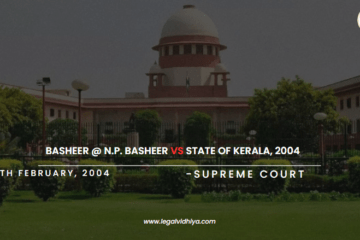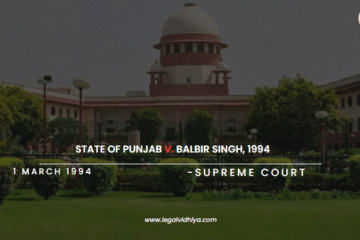
| Name of the case | Ishwar Devi Malik And Ors. vs. Union of India |
| Citation: | MANU/DE/0031/1969 |
| Coram: | I.D. Dua, C.J. and T.V.R. Tatachari, J. |
| Appellants: | Ishwar Devi Malik |
| Respondent: | UOI |
| Counsel for Appellant: | S.N. Chopra and R.L. Tandon, Advs |
| Counsel for Respondent: | D.D. Chawla, Adv. |
| Relevant Sections: | FATAL ACCIDENTS ACT, 1855 – Section 1-A |
| Acts/Rules/Orders | Code of Civil Procedure, 1908 (CPC) – Section 151; Code of Civil Procedure, 1908 (CPC) – Section 80; Delhi Municipal Corporation Act, 1957 – Section 478, Delhi Municipal Corporation Act, 1957 – Section 516(2); Fatal Accidents Act, 1855 – Section 1-A, Fatal Accidents Act, 1855 – Section 2 |
| Cases Referred: | Veena Kumari Kohli v. Punjab Roadways, 1967 Acc CJ 297 (Punj); Mohd. Habibulla v. K. Sitammal, 1966 Acc CJ 349 (Mad); Krishnamma v. Alice Veigos, 1966 Acc CJ 366, (1966) 2 Mys LJ 588; Kuldip Lal Bhardari v. Umed Singh, 1966 Acc CJ 110 (Punj); Masalti v. State of U.P., AIR 1965 SC 202, 1965 (1) Cri LJ 226; Pushpa Devi v. Municipal Corporation of Delhi, 2nd (1964) 1 Punj 529, FAO No. 80-D of 1959 dated 29.3.1963; Gobald Motor Service Ltd. v. R.M.K. Velu Swami, AIR 1962 SC 1, (1962) 1 SCR 929; Viscount Simon in Nance v. British Columbia Electric Railway Co. Ltd., 1951 AC 601, 1951-2 All ER 448 |
ABSTRACT:
It is well known that Indian tort law is based on English common law. As a result, the law governing negligence is established and updated by Indian courts based on the principles of justice, equity, and good conscience. Negligence is derived from the Latin word negligentia, which meaning ‘failure to pick up’. In the broad sense, neglect refers to the act of being careless, whereas in the legal sense, it refers to the failure to exercise a standard of care that the doer, as a reasonable man, should have exercised in a given situation. Negligence did not become a separate cause of action in English law until the 18th century. Similarly, the Indian Penal Code (IPC) of 1860 included no provision for causing a person’s death via negligence, which was later amended in 1870 by the addition of section 304A.
Definition of Negligence:
Negligence, according to Winfield and Jolowicz, is the breach of a legal duty of care by the plaintiff that results in unintended injury to the plaintiff. Negligence was defined in Blyth v. Birmingham Water Works Co as the failure to do something that a prudent or reasonable person would do or doing something that a prudent or reasonable person would not do.
It is classified into three types:
Nonfeasance: The act of failing to accomplish something that one should have done. For example, failing to repair an ancient building when it should have been done.
Misfeasance: The act of failing to perform an action properly when it should have been performed properly. For example, repairing an ancient building while using low-quality materials increases the likelihood of a collapse that injures people.
Malfeasance: The act of doing something that should never have been done in the first place. For example, utilizing prohibited and combustible materials to restore an ancient building, so converting the building into a firetrap and causing an accident.
Introduction and brief facts:
An order of the Motor Accident Claims Tribunal was challenged in this matter before the Delhi High Court. Six heirs of the dead filed the appeal, seeking compensation of Rs. 4,50,000 in lieu of the accident that killed the deceased at Farash Khana Bus Stop. The deceased, according to the applicants’ declaration, was 40 years old and worked for a company that paid him around Rs 1700 per month. He was at the aforementioned bus stop, waiting for a bus. Soon after, a DLP 230 bus came at the Bus Stop, and as the deceased climbed onto the vehicle’s footboard, the conductor rang the bell hastily and haphazardly, despite the fact that the deceased had not yet entered the bus, and the driver began moving. The applicants also alleged that after some time, the said Bus driver continued through another bus that was relatively close to the deceased, leading him to get sand-witched between the two cars, resulting in significant chest injuries and his death.
As a result, the applicants claimed that the deceased’s death was caused by the bus driver and conductor’s negligence.
ISSUES AT HAND:
The following are the major issues addressed in this case:
i.) Whether thedeceased, Sham Lal Malik, deceased as a consequence of the driver and conductor’s reckless and negligent conduct.
ii.) Is it feasible that Sham Lal Malik (dead) contributed to the negligence in some way?
iii.) How much compensation should be provided to applicants, and who should be accountable for paying it?
RULE:
The safety of passengers using public transportation should be the primary concern of those in charge of and in control of public transportation.On top of that, Section 110-A of the Motor Vehicles Act, 1939 has been applied, which states that an application for compensation arising from an accident of the nature specified in Section 110 (1) may be filed by the person who endured the injury, or where death ensued from the accident, by the legal representatives of the deceased, or by an agent duly authorized by the person injured or the legal representatives of the deceased, as the case may be, and a court of competent jurisdiction shall hear the application. Also, Section 1-A of the Fatal Accidents Act of 1855, which states that the beneficiaries of the deceased are entitled to remuneration for financial damages incurred as a result of the individual’s death, of which the recipients have been deprived. Furthermore, the Court used a principle to arrive at equitable reparation. According to this approach, the applicants’ monetary loss must be calculated by dividing the loss of future financial gain by the benefit received as a result of death.
Judgment:
The Court considered the first and second issues together since they are related in some way. According to the Court, the deceased boarded the bus while it was still moving, but while he was still placing his foot in the vehicle, and most of his body parts were lying outside the bus. Knowing this, the conductor rang the bell, and the driver took the wheel of the bus.
This conductor’s actions were hasty and careless. The driver acted similarly rashly and irresponsibly when driving alongside another standing Bus by not allowing adequate clearance. Concerning the issue of contributing carelessness on the part of the deceased, Sham Lal Malik, the Court determined that the bus was immovable when the aforementioned individual entered, hence contributory negligence is not of concern.
The Court applied the principle that the monetary loss to the applicants must be estimated by proportioning the loss to them of future financial benefits and the pecuniary gain that came to them as a result of death to determine compensation. Based on the Court’s calculations, the Court imposed Rs 25,500 in compensation for the deceased’s wife and children, as well as Rs 6,375 in compensation for the deceased’s mother and father, Sham Lal Malik.
ANALYSIS:
The Court examined the first and second problems together since they are related in some way. The Court considered the statements of three eyewitnesses in this regard. The biggest issue, though, was with eyewitness number three, Arjan Dass. According to the tribunal’s decision, this witness’ testimony cannot be considered and is invalid because he is the deceased’s true brother in law. However, the Court rejected the tribunal’s reasoning and relied on the Supreme Court ruling in Masalti V. Uttar Pradesh[8], which held that even in a criminal case, the Court cannot dismiss the evidence given by the interested person because the witness is interested in the individual, but the Court should keep this in mind and examine the correctness and genuineness of the evidence.
The Court ruled that the tribunal erred in not incorporating A.W7’s testimony because A.W1 and A.W3 both confirmed his correctness. According to the findings, the dead boarded the bus while it was still moving, but while he was still placing his foot in the vehicle, and the most of his body parts were lying outside the bus. Knowing these data, the conductor rang the bell and the driver began driving the bus.
The conductor’s action was reckless and careless. The driver also acted rashly and negligently by failing to provide appropriate clearance while driving by the side of another standing Bus. For this, the Court relied on Kuldip Lal Bhardari v. Umed Singh, which had some similarities to the facts of the current case. Concerning the issue of contributing negligence on the part of the dead, Sham Lal Malik, the Court held that the bus was motionless when the said individual boarded it, therefore the issue of contributory negligence does not arise.
In response to the third point, the Court stated that there are two types of damages or compensation receivable under the Fatal Accidents Act of 1855. The first is where the compensation is proportional to the loss caused by the death of the person identified in Section 1-A of the aforementioned statute. The second, which is stated in Section 2, discusses the loss suffered by the deceased’s estate. The Court stated that because the applicants did not submit compensation under the second kind, they were only applicable for the damage caused by the first type. As a result, the Court believes that this sort of compensation would be most appropriate in the current case.
The Court applied the premise that the monetary loss to the applicants must be calculated by dividing the loss of future financial benefit by the pecuniary advantage that occurred to them as a result of death. Based on the aforementioned criteria, the Court directed that compensation be paid to the deceased’s wife and children in the amount of Rs 25,500 apiece, as calculated by the Court, and that Rs 6,375 be paid to the parents of the deceased.
Conclusion:
The Court ruled that the driver and bus conductor were both accountable for hasty and negligent actions (respondents 4 and 5), and that the deceased died as a result of their actions.
The Court also ruled that the deceased, Sham Lal Malik, was not liable for contributory negligence. Furthermore, the Court ruled that all applicants be compensated. The court ruled that the Municipal Corporation of Delhi (Respondent No. 2) and the Delhi Transport Undertaking (Respondent No. 3) are obligated to give the claimants compensation. The Court underscored the notion that the safety of passengers utilizing public transportation should be the top priority for anybody in charge of public transportation through this decision. According to the Court, both the driver and the bus conductor were found guilty for their reckless and careless behavior. The Court also ruled that the deceased, Sham Lal Malik, was not liable for contributory negligence. Furthermore, the Court ordered that all petitioners be reimbursed. The court decided that the Delhi Municipal Corporation and the Delhi Transport Undertaking must pay the claims.
*******
This is written by S. Abhipsha Dash from Symbiosis Law School Pune as an intern under Legal Vidhiya




0 Comments